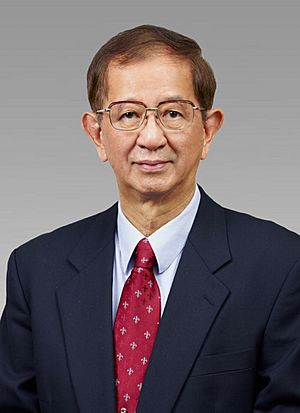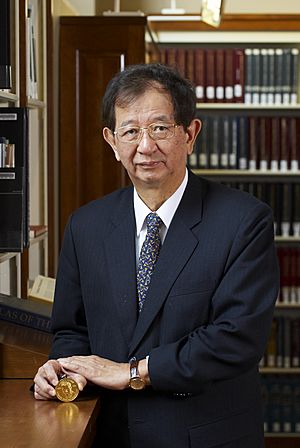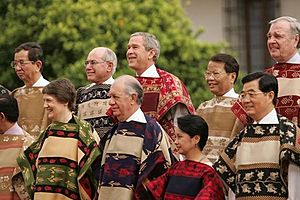Yuan T. Lee facts for kids
Quick facts for kids
Yuan Tseh Lee
|
|
|---|---|
| 李遠哲 | |

Official portrait, 2016
|
|
| Senior Advisor to the President | |
| In office 9 November 2016 – 19 May 2020 |
|
| President | Tsai Ing-wen |
| In office 20 May 2000 – 20 May 2001 |
|
| President | Chen Shui-bian |
| 7th President of the Academia Sinica | |
| In office 18 January 1994 – 18 October 2006 |
|
| President | Lee Teng-hui Chen Shui-bian |
| Preceded by | Wu Ta-You |
| Succeeded by | Chi-Huey Wong |
| Personal details | |
| Born | 19 November 1936 Shinchiku City, Shinchiku Prefecture, Japanese Taiwan |
| Citizenship | Taiwan |
| Nationality | Empire of Japan (1936–1945) Republic of China (1945–present) United States (1974–1994) |
| Political party | Independent |
| Education | National Taiwan University (BS) National Tsing Hua University (MS) University of California, Berkeley (PhD) |
| Awards | Nobel Prize in Chemistry (1986) National Medal of Science (1986) Peter Debye Award (1986) Faraday Lectureship Prize (1992) Othmer Gold Medal (2008) |
| Scientific career | |
| Fields | Chemistry |
| Institutions | University of California, Berkeley University of Chicago Lawrence Berkeley National Laboratory Academia Sinica (Taiwan) |
| Thesis | Photoionization of alkali-metal vapors (1965) |
| Doctoral advisor | Bruce H. Mahan |
| Doctoral students | Laurie Butler |
Yuan Tseh Lee (Chinese: 李遠哲; pinyin: Lǐ Yuǎnzhé; Wade–Giles: Li³ Yüan³-che²; Pe̍h-ōe-jī: Lí Oán-tiat; born 19 November 1936) is a Taiwanese chemist. He is a Professor Emeritus at the University of California, Berkeley. He was the first Taiwanese Nobel Prize laureate who, along with the Hungarian-Canadian John C. Polanyi and American Dudley R. Herschbach, won the Nobel Prize in Chemistry in 1986 "for their contributions to the dynamics of chemical elementary processes".
Lee's particular physical chemistry work was related to the use of advanced chemical kinetics techniques to investigate and manipulate the behavior of chemical reactions using crossed molecular beams. From 15 January 1994 to 19 October 2006, Lee served as the President of the Academia Sinica of Taiwan. In 2011, he was elected head of the International Council for Science.
Contents
Early life and education
Lee was born to a Hokkien family in Shinchiku City (modern-day Hsinchu city) in northern Taiwan, which was then under Japanese rule, to Lee Tze-fan, an artist, and Ts'ai P'ei (Chinese: 蔡配; pinyin: Cài Péi), an elementary school teacher from Goseikō Town (梧棲港街), Taichū Prefecture (Wuqi, Taichung). Lee is a Hokkien with ancestry from Nan'an City, China. Lee played on the baseball and ping-pong teams of Hsinchu Elementary School, and later studied at the Hsinchu Senior High School, where he played tennis, trombone, and the flute.
He was exempted from the entrance examination and directly admitted to National Taiwan University. He earned a B.S. in 1959. He earned his M.S. from National Tsing Hua University in 1961 and his Ph.D. from the University of California, Berkeley, in 1965 under the supervision of Bruce H. Mahan. He was a member of the Chemistry International Board from 1977 to 1984.
Scientific career
Chemistry
In February 1967, he started working with Dudley Herschbach at Harvard University on reactions between hydrogen atoms and diatomic alkali molecules and the construction of a universal crossed molecular beams apparatus. After the postdoctoral year with Herschbach he joined the University of Chicago faculty in 1968. In 1974, he returned to Berkeley as professor of chemistry and principal investigator at the Lawrence Berkeley National Laboratory, becoming a U.S. citizen the same year. Lee is a University Professor Emeritus of the University of California system.
Nobel prize
One of the major goals of chemistry is the study of material transformations where chemical kinetics plays an important role. Scientists during the 19th century stated macroscopic chemical processes consist of many elementary chemical reactions that are themselves simply a series of encounters between atomic or molecular species. In order to understand the time dependence of chemical reactions, chemical kineticists have traditionally focused on sorting out all of the elementary chemical reactions involved in a macroscopic chemical process and determining their respective rates.
Swedish chemist Svante Arrhenius studied this phenomenon during the late 1880s, and stated the relations between reactive molecular encounters and rates of reactions (formulated in terms of activation energies).
Other scientists at the time also stated a chemical reaction is fundamentally a mechanical event, involving the rearrangement of atoms and molecules during a collision. Although these initial theoretical studies were only qualitative, they heralded a new era in the field of chemical kinetics; allowing the prediction of the dynamical course of a chemical reaction.
In the 1950s, 1960s and 1970s, with the development of many sophisticated experimental techniques, it became possible to study the dynamics of elementary chemical reactions in the laboratory. Such as the analysis of the threshold operating conditions of a chemical laser or the spectra obtained using various linear or non-linear laser spectroscopic techniques.
Professor Lee's research focused on the possibility to control the energies of the reagents, and to understand the dependence of chemical reactivity on molecular orientation, among other studies related to the nature of reaction intermediates, decay dynamics, and identifying complex reaction mechanisms. To do so, Professor Lee used a breakthrough laboratory technique at the time, called the "crossed molecular beams technique", where the information derived from the measurements of angular and velocity distributions allowed him and his team to understand the dynamics of elementary chemical reactions.
Recent works
During his tenure, Lee has worked to create new research institutes, advance scientific research within Taiwan, and to recruit and cultivate top scholars for the Academic Sinica.
In 2010, Lee said that global warming would be much more serious than scientists previously thought, and that Taiwanese people needed to cut their per-capita carbon emissions from the current 12 tons per year to just three. This would take more than a few slogans, turning off the lights for one hour, or cutting meat consumption, noting: "We will have to learn to live the simple lives of our ancestors." Without such efforts, he said, "Taiwanese will be unable to survive long into the future".
He has been involved with the Malta Conferences, an initiative designed to bring together Middle Eastern scientists. As part of the initiative, he offered six fellowships to work on the synchrotron in Taiwan.
He is also a member of International Advisory Council in Universiti Tunku Abdul Rahman.
Personal life
Lee's father was a painter in Taiwan. His mother was an elementary school teacher, and his elder brother, Yuan-Chuan Lee, has been a professor in at Johns Hopkins University for 40 years, awarded the honor Special Chair Lectureship in Academia Sinica in Taiwan. Besides, his younger brother, Yuan-Pern Lee, also awarded this honor. Lee's sister, Chi-Mei Lee has served as a professor in National Chung Hsing University.
In 2003, he was one of 22 Nobel Laureates who signed the Humanist Manifesto.
Political role
During the 2000 Presidential Election, Lee has been a supporter of the Pan-green coalition which advocates Taiwan independence. In the last week of the election he announced his support for the candidacy of Chen Shui-bian who subsequently won over James Soong. Chen intended to nominate Lee to become Premier. Lee has been the President of the Academia Sinica since 1994 and renounced his U.S. citizenship to take the post. As president of Academia Sinica he presided over the creation of the Taiwanese history textbook Knowing Taiwan.
At the request of Chen, Lee was the Republic of China's representative in the 2002 APEC leaders' summit in Mexico. (Presidents of the Republic of China have been barred from joining the APEC summits because of objections from the People's Republic of China.) Lee represented Chen again in the 2003 and 2004 APEC summits in Thailand and Chile, respectively.
In January 2004, he and industrial tycoon Wang Yung-ching and theatre director Lin Hwai-min issued a joint statement to both Chen Shui-bian and Lien Chan. He backed Chen again in the 2004 elections when he issued a statement of support for the DPP on 17 March, three days before polls opened. Lee was then elected President of the International Council for Science in 2008, to start his term in 2011.
During the 2012 Republic of China presidential elections, Lee expressed his support for DPP candidate Tsai Ing-wen. In early 2016, he appeared and addressed a rally by New Power Party-a party formed by student activists involved in the Sunflower Movement.
Climate change
Yuan Lee has signed the 2015 Mainau Declaration expressing concern about anthropogenic climate change.
Wu Chien-Shiung Foundation
Lee was one of the four Nobelists who established the Wu Chien-Shiung Foundation.
Recognition
In addition to the Nobel Prize, his awards and distinctions include Sloan Fellow (1969); Fellow of American Academy of Arts and Sciences (1975); Fellow Am. Phys. Soc. (1976); Guggenheim Fellow (1977); Member National Academy of Sciences (1979); Member International Academy of Science, Munich, Member Academia Sinica (1980); E.O. Lawrence Award (1981); Miller Professor, Berkeley (1981); Fairchild Distinguished Scholar (1983); Harrison Howe Award (1983); Peter Debye Award (1986); National Medal of Science (1986); Golden Plate Award of the American Academy of Achievement (1987) and Faraday Lectureship Prize (1992). Yuan Tseh Lee was awarded the Othmer Gold Medal in 2008 in recognition of his outstanding contributions to progress in chemistry and science. His post-doctoral supervisor and fellow Nobel Laureate Dudley Herschbach congratulated Lee. In 2019 Yuan T. Lee was also awarded the Fray International Sustainability Award by FLOGEN Star Outreach at SIPS 2019.
See also
 In Spanish: Yuan T. Lee para niños
In Spanish: Yuan T. Lee para niños



